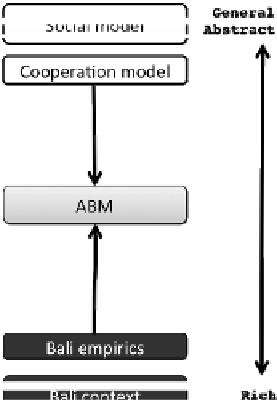Information Technology Reference
In-Depth Information
change. One of the main identified needs is to get basic information and understand-
ing of SES dynamics to evaluate, learn and improve SES management [2]. Most work
done in sustainability research/common pool research focuses either on rich descrip-
tive case studies of real world cases or on highly abstract analytical models [3]. Both
have their strengths by either having a strong relation to the real world phenomenon
(case studies) or explorative power and clarity (generic models). Within this need of
understanding we see a role for agent-based modelling: 1) to embed the complex
adaptive nature of social-ecological systems; 2) to provide an insightful middle
ground between (abstract) generic models and the (rich) real case studies; and 3) to
provide a systematic way to discern between important general aspects of the social
and ecological context of the social dilemma and case specific factors. We explore the
contextualisation of concepts, mechanisms and interactions of a generic model and
thereby to integrate general aspects of the social-ecological context that are relevant
for explaining sustainable outcomes in complex SES. In the following we describe
our first steps into an ABM case study: the contextualisation of an (abstract) model of
cooperation in the case of Bali irrigation, see figure 1.
Fig. 1.
The positioning of our approach in modelling an ABM case study
1.1
Bali Irrigation as an ABM Case Study
Bali irrigation is one of the well-know examples of a self-organised 'escape' of the
'tragedy of the commons' [4]. The tragedy of the commons describe the inevitable
outcome of overexploiting shared resources in absence of a central authority [5]. Rice
paddy farmers in Bali are part of a community-level organisation devoted to the






